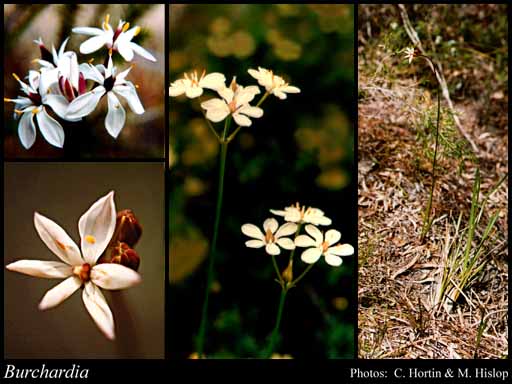- Reference
- Prodr.Fl.Nov.Holland. 272 (1810)
- Name Status
- Current







Scientific Description
Common name. Burchardias. Family Colchicaceae.
Sometimes included in Liliaceae - Colchiceae.
Habit and leaf form. Herbs. Perennial (above ground parts annual). Leaves basal and cauline. Plants with a basal concentration of leaves, or with neither basal nor terminal concentrations of leaves. Young stems erect, simple or branched, herbaceous. Cormous (with papery scales), or tuberous. Mesophytic. Leaves alternate; spiral, or distichous; sessile; sheathing; simple. Leaf blades entire; linear, or lanceolate; linear; parallel-veined; without cross-venules; sheathing. Leaves without stipules. Leaf blade margins entire. Leaf anatomy. Hairs absent. Extra-floral nectaries absent. Stem anatomy. Secondary thickening absent.
Reproductive type, pollination. Fertile flowers hermaphrodite. Unisexual flowers absent. Plants hermaphrodite. Floral nectaries present. Nectar secretion from the perianth, or from the androecium.
Inflorescence and flower features. Flowers solitary, or aggregated in ‘inflorescences’; in umbels (in the Perth region). The terminal inflorescence unit cymose, or racemose. Inflorescences scapiflorous, or not scapiflorous; terminal; scape simple or 1–4 branched, 1–4 leaves or 1–4 bracts; inflorescence of about 20 flowers; with involucral bracts. Flowers pedicellate; bracteate; ebracteolate; small to large; regular; 3 merous; cyclic; pentacyclic. Perigone tube absent. Perianth of ‘tepals’; 6; 1 -whorled; free; petaloid; without spots, or spotted; similar in the two whorls (in size and form); green (greenish), or white (pinkish-white), or pink. Androecial members definite in number. Androecium 6. Androecial members free of the perianth to adnate (to the tepal bases and receptacle); all equal; free of one another; 1 -whorled, or 2 -whorled. Androecium exclusively of fertile stamens. Stamens 6; all more or less similar in shape; diplostemonous; on segment base and receptacle opposite the perianth segments; alterniperianthial. Anthers dorsifixed (or near the base); versatile; dehiscing via longitudinal slits; almost latrorse, or extrorse; tetrasporangiate. Gynoecium 3(–4) carpelled. The pistil 3 celled. Carpels isomerous with the perianth. Gynoecium syncarpous; synovarious to synstylovarious; superior. Ovary plurilocular; 3 locular; sessile (but tapering at the base). Gynoecium stylate. Styles 1; free to partially joined; apical. Stigmas 3; 3 - lobed. Placentation axile. Ovules several, numerous; anatropous to campylotropous.
Fruit and seed features. Fruit non-fleshy; dehiscent; a capsule. Capsules septicidal. Fruit 3 celled. Seeds endospermic. Endosperm oily. Cotyledons 1 (conspicuously coleoptile-like). Embryo straight. Testa without phytomelan.
Etymology. After Johann Heinrich Burckhard (1676–1738), German botanist and correspondent of Leibnitz.
Taxonomic Literature
- Wheeler, Judy; Marchant, Neville; Lewington, Margaret; Graham, Lorraine 2002. Flora of the south west, Bunbury, Augusta, Denmark. Volume 1, introduction, keys, ferns to monocotyledons. Australian Biological Resources Study.. Canberra..